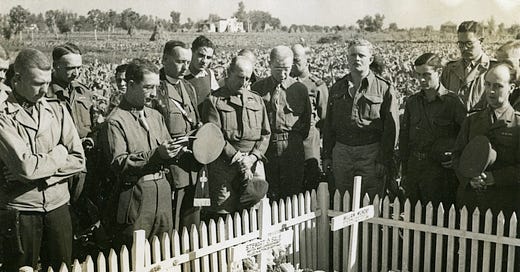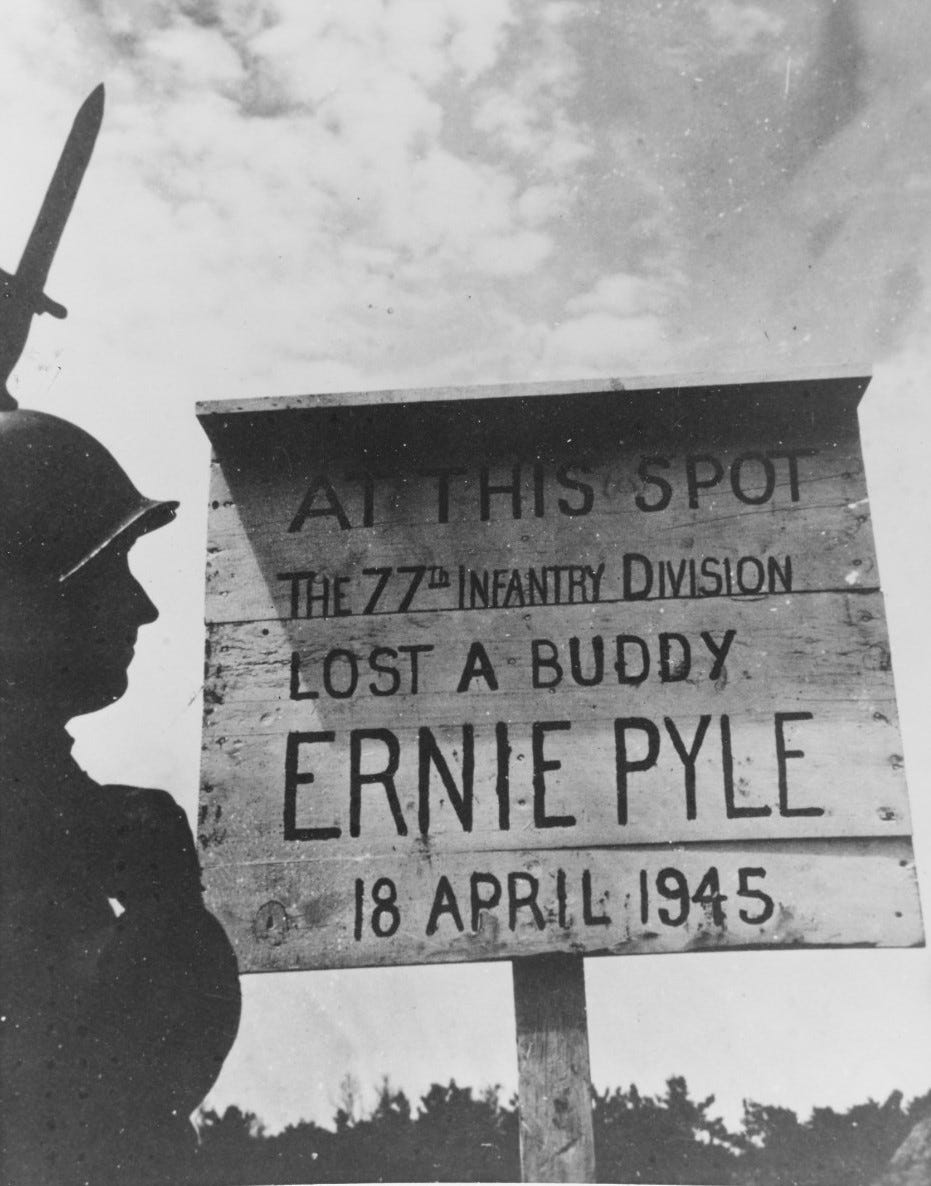Remembering journalists killed covering World War II
Correspondents covering World War II understood the risks inherent in the assignment, and it was inevitable that some of them would die in the line of duty alongside the fighting men and women whose stories they were telling.
Here, we remember the correspondents who didn't come back. Click on any links to read more about that person's specific story.
Nov. 18, 1940 -- Ralph Barnes of the New York Herald Tribune died when the RAF Wellington bomber he was aboard crashed into a mountain in what is now Montenegro.
Dec. 15, 1941 -- Alexander Massy Anderson of Reuters went down with the HMS Galatea after the ship was torpedoed off Alexandria, Egypt.
Mar. 7, 1942 -- D. Witt Hancock of the Associated Press went down aboard the Dutch ship Poeloe Bras after it was hit by a Japanese bomber while fleeing Java.
Apr. 19, 1942 -- Harry L. Percy of the United Press died of malaria in Cairo.
Apr. 24, 1942 -- Lea Schiavi Burdett of PM was shot to death in Iran.
Apr. 29, 1942 -- Melville Jacoby of Time was killed when he was struck by a transport plane that lost control after landing at an Australian airfield.
July 2, 1942 -- Eugene Petrov, Russian novelist turned war correspondent for the North American Newspaper Alliance, was killed at Sevastopol.
Sept. 15, 1942 -- Jack Singer of the International News Service was killed when the USS Wasp was torpedoed by a Japanese submarine near Guadalcanal.
Oct. 18, 1942 -- Byron Darnton of the New York Times was killed by friendly fire after a B-25 mistakenly strafed the small U.S. transport ship he was aboard off New Guinea.
Feb. 1, 1943 -- Harry Crockett of the Associated Press died when the HMS Welshman was torpedoed by a U-boat off Egypt.
Feb. 22, 1943 -- Frank Cuhel of Mutual Broadcasting and Ben Robertson of the New York Herald Tribune were among the 20 aboard killed when a Yankee Clipper USO flight that crashed into the Tagus River near Lisbon.
Feb. 26, 1943 -- Robert P. Post of the New York Times, a member of the celebrated "Writing 69th," did not return from covering a bombing raid on Wilhelmshaven.
July 20, 1943 -- Carl Thusgaard, a photographer for ACME Newspictures, was killed when the B-24 he was aboard went down over New Zealand after a running battle with multiple Japanese Zeros.
Sept. 28, 1943 -- A.B. Austin of the London Daily Herald, William Munday of the Sydney Morning Herald and Stewart Sale of Reuters were killed by a volley from a German armored vehicle in Nocera, Italy.
Nov. 7, 1943 -- Keith Palmer of the Melbourne Herald, Sydney Sun and Newsweek died when a Japanese bomb landed outside the press hut on Bougainville.
Dec. 2, 1943 -- Nordahl Grieg, a poet working as a war correspondent for the Norwegian government, died when the RAF Lancaster he was aboard on a bombing raid to Berlin was shot down.
Dec. 12, 1943 -- Lucien Labaudt, a renowned painter working as a war artist for Life, was killed in a plane crash in Assam, India.
Dec. 27, 1943 -- Brydon Taves of the United Press and Pendil Rayner of the Brisbane Telegraph died from injuries suffered in a plane crash in New Guinea.
Feb. 2, 1944 -- Raymond Clapper, Scripps-Howard columnist, died when the plane he was aboard over the Marshall Islands collided with another and crashed into a lagoon.
Feb. 19, 1944 -- John Bushemi, photographer for Yank magazine, was killed by shrapnel from Japanese mortar rounds while covering the landings on Eniwetok.
Mar. 24, 1944 -- Stuart Emeny of the News Chronicle and Stanley Wills of the Daily Herald died in a B-25 crash in Burma.
May 11, 1944 -- Frederick Faust, the prolific pulp fiction author and screenwriter better known by his pen name Max Brand, was killed by shrapnel near Santa Maria Infante, Italy while on assignment for Harper's.
May 18, 1944 -- Cyril Bewley of Kemsley Newspapers and Roderick MacDonald of the Sydney Morning Herald were killed after triggering a mine while seeking cover from a mortar attack in Cassino, Italy.
June 11, 1944 -- Arthur Thorpe of the Exchange Telegraph news agency was killed at sea.
June 16, 1944 -- Bill Shenkel of Newsweek accompanied the first B-29 raid on the Japanese home islands but did not return.
June 22, 1944 -- Kent Stevenson of the BBC was aboard an RAF Lancaster that failed to return from a raid on the Cologne area.
July 25, 1944 -- Bede Irvin, an Associated Press photographer, was killed by friendly fire near Saint-Lô as Operation Cobra launched.
Aug. 10, 1944 -- Harold Kulick, photographer for Popular Science Monthly, died when the B-26 he was aboard crash-landed in England after being hit by anti-aircraft fire over France.
Aug. 17, 1944 -- Bill Stringer of Reuters was killed by an explosion near Chartres. This piece covers Stringer's death, as well as the Treanor and Makin incidents listed below.
Aug. 19, 1944 -- Tom Treanor of the Los Angeles Times and NBC died of injuries suffered when a Sherman tank ran over the jeep in which he was riding.
Aug. 26, 1944 -- William J. Makin of Kemsley Newspapers died nearly two weeks after he was shot in the stomach in a German ambush near Chartres.
Sept. 17, 1944 -- Damien Parer, newsreel cameraman for Paramount, was killed by machine-gun fire covering the fighting on Peleliu.
Oct. 19, 1944 -- David Lardner of The New Yorker died after the jeep in which he was riding triggered a land mine near Aachen.
Oct. 25, 1944 -- Asahel Bush of the Associated Press died instantly when a Japanese plane dropped a bomb on the house in the Philippines where he and several other correspondents were staying. This piece discusses Bush as well as Stanley Gunn and John B. Terry, who succumbed days later.
Oct. 29, 1944 -- Stanley Gunn of the Fort Worth Star-Telegram died of his wounds from the above incident.
Oct. 31, 1944 -- John B. Terry of the Chicago Daily News died of his wounds from the above incident.
Nov. 5, 1944 -- John J. Andrew of the United Press was aboard a B-29 that disappeared over the Bay of Bengal.
Nov. 12, 1944 -- Frank Prist Jr., a photographer for ACME Newspictures, was killed by a sniper while riding in a jeep in Leyte.
Dec. 23, 1944 -- Jack Frankish of the United Press was killed by shrapnel from a German bomb that landed outside a hotel in Chaudfountaine, Belgium.
Jan. 6, 1945 -- William Chickering of Time and Life died in a kamikaze strike on the USS New Mexico in the Lingayen Gulf.
Jan. 24, 1945 -- Joe Morton of the Associated Press was executed by the Nazis after being captured while accompanying an OSS operation in Czechoslovakia.
Feb. 3, 1945 -- Guy Byam of the BBC was aboard an Eighth Air Force B-17 that failed to return from a bombing raid on Berlin.
Mar. 10, 1945 -- Peter Lawless of the Telegraph was killed by a German artillery round at the Remagen bridgehead.
Mar. 30, 1945 -- Frederick C. Painton of Reader's Digest and other magazines died of a heart attack at a B-29 base on Guam.
Apr. 18, 1945 -- Ernie Pyle of Scripps-Howard was killed by a Japanese machine gunner on Ie Shima.
July 3, 1945 -- John Elliott of the Australian Broadcasting Company was killed by Japanese fire at Balikpapan, Borneo.
July 31, 1945 -- John R. Cashman of the International News Service was on a B-24 that crashed just after takeoff on Okinawa, killing everyone aboard.





